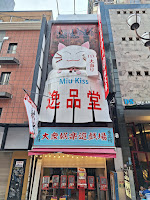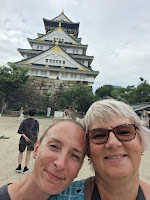 |
| Todai-ji |
 Päeval oli plaanis külastada Narat ja Osakat. Seekord Suica töötas bussis nii nagu ette nähtud ning juba tuttav tee viis meid Kyoto jaama, kus liikusime Nara liiniga (JR) edasi Nara suunas.
Päeval oli plaanis külastada Narat ja Osakat. Seekord Suica töötas bussis nii nagu ette nähtud ning juba tuttav tee viis meid Kyoto jaama, kus liikusime Nara liiniga (JR) edasi Nara suunas.
 Nara oli Jaapani pealinn 8. sajandil. Tänapäeval on suur rõhk turistidel.
Nara oli Jaapani pealinn 8. sajandil. Tänapäeval on suur rõhk turistidel.
Nara jaamast liikusime edasi bussiga, mis viis meid tutvuma Todai-ji templiga. Bussijaamast kõige otsesem tänav ei olnud tegelikult peatänav, nagu hiljem selgus ja see oli kokkuvõttes hoopis lahedam lähenemistee. Inimesi ei olnud, nägin lähedalt ja ilma tasuta bambuseid. Lühikese jalutuskäigu pärast jõudsime templikompleksi aiani, kus ootasid ees hirved.





Osaka loss näeb välja sarnane Hiroshima lossile. Tee sinna viis üle lossi vallikraavide. Nagu eelnevalt, nägime pargitud ja täiesti lukustamata rattaid. Ei olnud rendikad, lihtsalt rattad. Pärast metroo poole tagasi liikudes olid need rahulikult samal kohal. Läbi puudesalu liikudes kuulsime tsikaadi, kelle lõpuks lähedalt ära nägin.
Osaka loss on sarnaselt Hiroshima omale muuseum. Hoone on väljast viie ja seest ametlikult kaheksakorruseline kuigi reaalselt kuues korrus sellel puudus. Magic. Oleks aru saanud, kui korrus 4, mis on Jaapanis ebaõnne number, puudunud oleks. Ülevalt vaatetornist traditsiooniline vaade ümbruskonnale.


 Tänav paistis silma lõpmatult lahedate (liikuvate) reklaamide poolest. Umbes viieks minutiks saime uduvihma hoo, mida ema täielikult nautis. Seekord oi mõttekas Osakas õhtust süüa, et Kyotos sentosse minnes natuke kergem oleks.
Tänav paistis silma lõpmatult lahedate (liikuvate) reklaamide poolest. Umbes viieks minutiks saime uduvihma hoo, mida ema täielikult nautis. Seekord oi mõttekas Osakas õhtust süüa, et Kyotos sentosse minnes natuke kergem oleks.
Restorani reklaamtoidud (paljudes kohtades olid akendele pandud toitude kujutised) paistsid täiesti normaalsed aga minu pasta oli meh. Minu magustoit. Ütleme nii, et see ei olnud üks paremaid, mida ma saanud olen. Või, noh, see oli päris mitte eriti maitsev.
Seejärel metroo ja Shinkanseni sõit Kyotosse ja õhtu lõpetuseks sento, kus seekord oli väga armas jaapanlanna. Ta elas meile täielikult kaasa kui me külmavee vanniks ennast kogusime ja siis selle ära tegime (ema tunduvalt kiiremini, kui mina). Ta jutustas palju ja me ei saanud üksteisest midagi aru aga miimikast ja kehakeelest täiesti piisas. Juba esimesel õhtul olime sentosse sisenedes natuke nõutud. Nagu eelnevalt kogetud, ükskõik mis keelt räägitakse, inimesed on äärmiselt abivalmid ja see on tohutult armas.
Mul on olnud õnn veeta 19. juuli Londonis, Dublinis, Roomas, Clovellys, Lake Districtis, Moheris, Cornwallis, Bledis, Skye saarel, Snowdoni tipus, Capril, Jurmalas, Pariisi Disneylandis, Barcelonas ja nüüd lisandus nimekirja Jaapan, täpsemalt Nara ja Osaka💗

 The plan for the day was to visit Nara and Osaka. This time, Suica worked as supposed to on the bus, and the already familiar path took us to Kyoto station, where we continued on the Nara line (JR) to Nara. Nara was the capital of Japan in the 8th century. Today, they are mostly directed to tourists.
From Nara Station, we took a bus that took us to Todai-ji Temple. As it turned out, we didn't take the main street from the bus station, but it was much more exciting. There were no people, I saw bamboo up close without having to pay for it. After a short walk, we reached the garden of the temple complex, where we saw a bunch of deer.
The plan for the day was to visit Nara and Osaka. This time, Suica worked as supposed to on the bus, and the already familiar path took us to Kyoto station, where we continued on the Nara line (JR) to Nara. Nara was the capital of Japan in the 8th century. Today, they are mostly directed to tourists.
From Nara Station, we took a bus that took us to Todai-ji Temple. As it turned out, we didn't take the main street from the bus station, but it was much more exciting. There were no people, I saw bamboo up close without having to pay for it. After a short walk, we reached the garden of the temple complex, where we saw a bunch of deer.
 |
| Buddha Vairocana |
We enjoyed the temple's garden and took photos of the deer, which could be fed for money. The deer weren't bothered by people the slightest and followed everyone who carried deer crackers. Todai-ji's Garden is also called Deer Park.
We also walked went to see the Kofuku-ji temple but skipped visiting it. On the way back to Nara train station, we found another conveyor sushi place. The similar system of coloured plates as in the previous one. I was brought a tray for my backpack, which I placed under the table. When I went to pay the bill, I managed to forget my bag under the table. At the end of the day, it wouldn't have been too bad, just my blue skirt and our water bottles. We were already paying when the attendant brought us the bag.

Naturally, I had thought the route through in advance, but when we were riding towards Osaka, I discovered that it is not necessary to ride all the way to Osaka station to visit the castle. Instead, we changed our train to the metro and saved some time.
Osaka is the third largest city in Japan, it was briefly the capital of Japan, and according to the 2020 census, two entire Estonia's populations would fit there😁
 Osaka Castle reminds Hiroshima Castle. We had to walk through a park bordered by moats to arrive there. As previously, we noticed parked and unlocked bikes in the park, which could never happen in Estonia, as sad as that is. After moving back towards the metro, the bikes were still in place. Moving through the grove of trees, we heard a cicada, which I finally saw up close.
Osaka Castle reminds Hiroshima Castle. We had to walk through a park bordered by moats to arrive there. As previously, we noticed parked and unlocked bikes in the park, which could never happen in Estonia, as sad as that is. After moving back towards the metro, the bikes were still in place. Moving through the grove of trees, we heard a cicada, which I finally saw up close.
Like Hiroshima, Osaka Castle is a museum. The building has five storeys on the outside and eight storeys on the inside, although, in reality, it lacked a sixth floor. Mystery. I would have understood if it had lacked floor 4, which is an unlucky number in Japan. As usual, the top offers a view of the surroundings.

 The last destination of the day was the historic Dotonbori Dori, which was originally a theatre district but today is a colourful food and entertainment centre. The street is distinguished by its numerous fancy (moving) advertisements. For about five minutes, we got a slight drizzle, which Mum thoroughly enjoyed. This time, it made sense to have dinner in Osaka, to have a bit of time to digest before visiting the Sento in Kyoto.
The last destination of the day was the historic Dotonbori Dori, which was originally a theatre district but today is a colourful food and entertainment centre. The street is distinguished by its numerous fancy (moving) advertisements. For about five minutes, we got a slight drizzle, which Mum thoroughly enjoyed. This time, it made sense to have dinner in Osaka, to have a bit of time to digest before visiting the Sento in Kyoto.
Many places had replicas of food on the windows. The place we opted for looked completely fine but my pasta was meh. My dessert. Let's just say it wasn't one of the best I've had.
Then the metro and Shinkansen ride to Kyoto to end the evening in our Sento, where this time we met a charming Japanese lady. She explained a lot and wasn't at all bothered that we didn't understand each other, all it took was the body language and facial expressions. She was so encouraging when we gathered ourselves to take a bath in the cold water (and actually managed to, Mum faster than me). We encountered helpfulness from the very beginning, which is so heartwarming.
I have been blessed to spend the 19th of July in London, Dublin, Rome, Clovelly, Lake District, Moher, Cornwall, Bled, Isle of Skye, Snowdon Peak, Capri, Jurmala, Disneyland Paris, Barcelona and now Japan has been added to the list, specifically Nara and Osaka💗







No comments:
Post a Comment